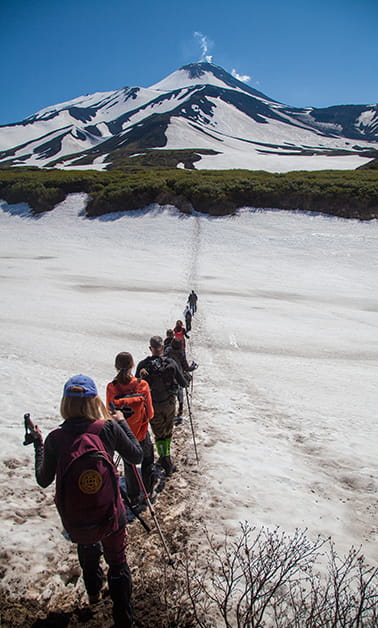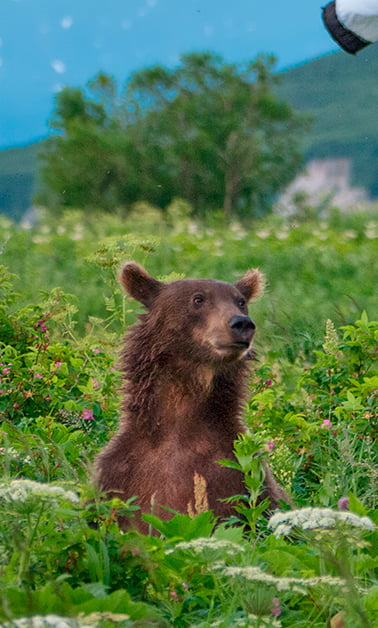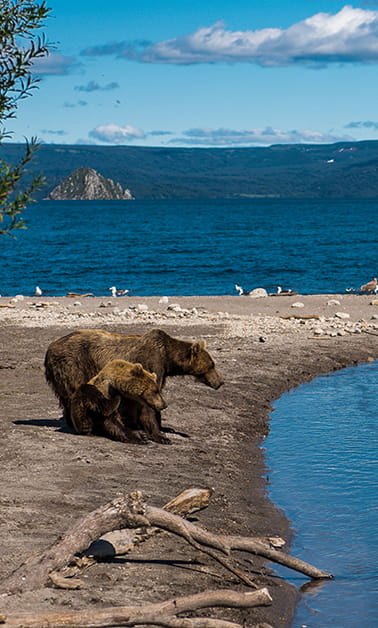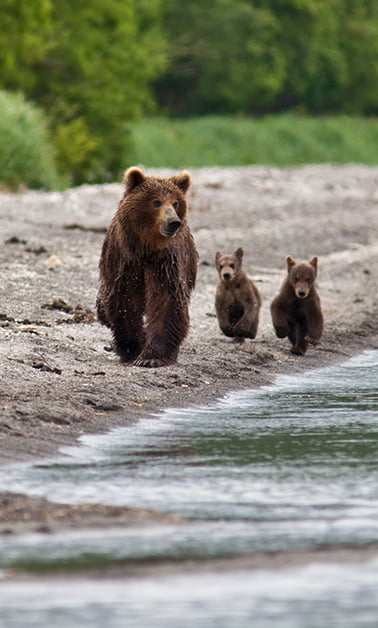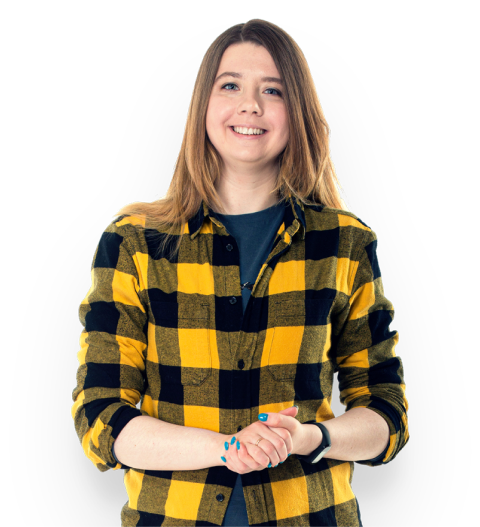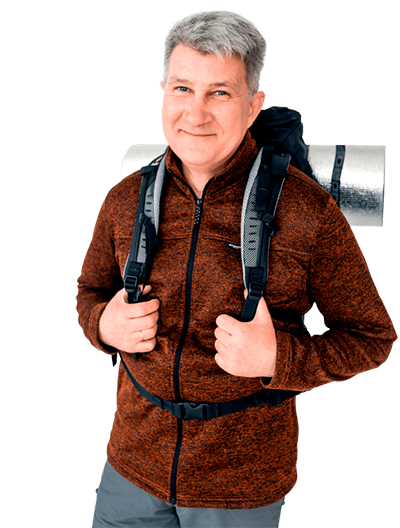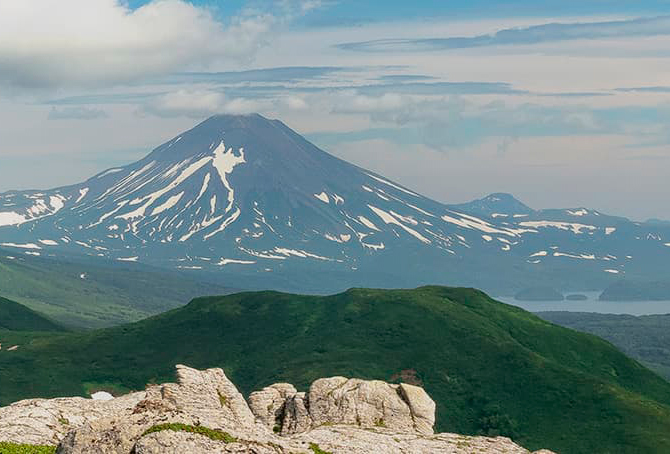
Kuril Lake
Kuril Lake is the largest spawning ground for seals in Eurasia. This attracts a huge number of bears from all over Kamchatka. A real bear feast!
The Kurile Lake is a crater lake situated on the south of the Kamchatka peninsula, at the territory of the South-Kamchatka Sanctuary. The lake is surrounded by rocky shores and heavy-going brushwood. Generally speaking, the lake may give a leader place only to the Kronotsky lake, in accordance with its size. Lake Kuril is the second largest freshwater lake in Kamchatka (with an area of 12, 5 х 8 kilometers).
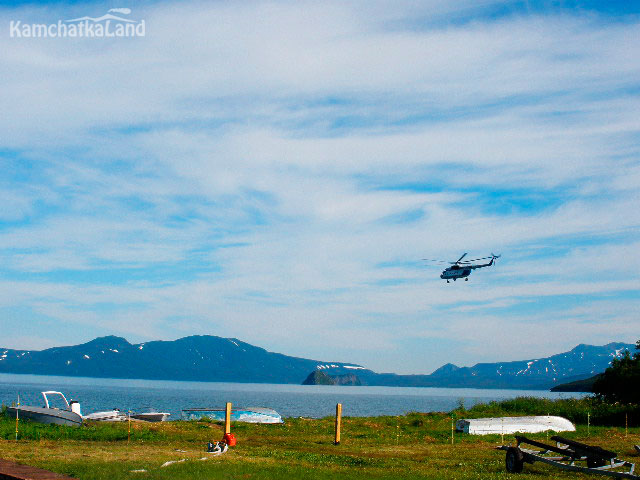
It seems that the life flows by another calm and leisurely way, and enjoys every moments there. Surroundings are wonderful like in a fairytale, so the territory of the Sanctuary, where there is the Kuril Lake, included in the list of UNESCO World Heritage Sites since 1996. This is not the last interesting fact! We tell you about many of them below and we are sure that you will want to see this marvelous place and its sites with your eyes!

Kurile Lake on a map
The Kurile Lake is located on the southern part of the Kamchatka Peninsula and it can be seen without zooming in. The coordinates on the Russian map is the following: 51°27′18″N, 157°5′54″E
It is very difficult to reach the Sanctuary because of remoteness from the capital city of Kamchatka Krai. There are two options to reach it: by a helicopter or an off-road vehicle. Both transports have positive and negative sides. The main criterions are distinguished, such as: price, conveniences, driving time, as well as the depending on weather conditions. Using a helicopter, you will save time and travel with comfort but the price of such trip will be more expensive and flight a lot depends on weather. Using an off-road vehicle, the price will be cheaper and your trip won’t a lot depends on weather, but it takes more time to reach the lake and, frankly, it will be not such a comfortable trip.

South-Kamchatka Sanctuary
The Kurile Lake is located at the territory of the South-Kamchatka Federal Sanctuary covering the vast area on the south of the peninsula including a few kilometers of the coastlines. The sanctuary security and regulations are enough strict since this is the only reserve of federal jurisdiction in Kamchatka region. Workers and volunteers working there supervising the preservation of rare animal and bird species, such as bighorn sheep, sea otter, brown bear, spotted seals, bean goose, Steller's sea eagle and many others.
To diminish anthropogenic effect on nature, the visiting the lake is limited with quotas provided by the state. Our company receives permission on visiting the territory a year before the tour starts and the tours have fixed date for visiting the sanctuary. Now every year we create two groups but we get much more inquiries for the tour.
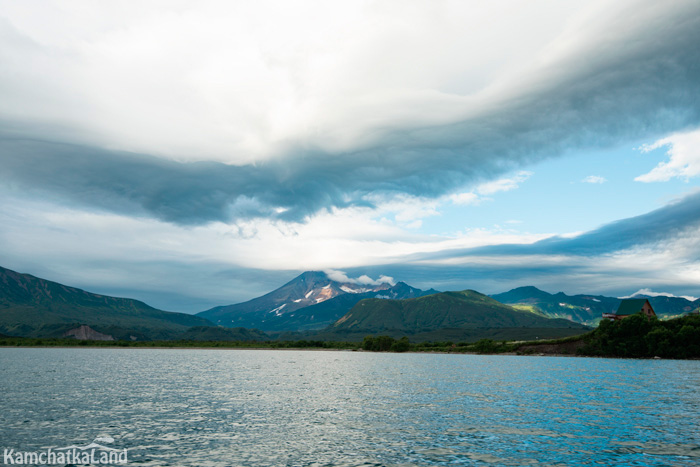
Weather on the lake
In some years in winter the lake is not covered with ice thanks to its size. Imagine that average temperature is enough high. In September the temperature of water reaches 7,6 °C and notice that this is not maximum one which equals to 10,8 °C!

The proximity of sea of Okhotsk impacts a lot on weather. The sea is not calm and often the weather is windy, foggy or rainy on the territory of the Sanctuary. However, the volcanoes and mountains, looking like guards taking the hit on themselves, protect it.
The weather is very changeable and unpredictable there. For example, if you take a trip from the camp to white waterfall or stone town on sunny day, but during hiking the weather will be able to change immediately along a whole route. However, after returning the camp you will be able to know that the weather was calm and sunny in the camp.
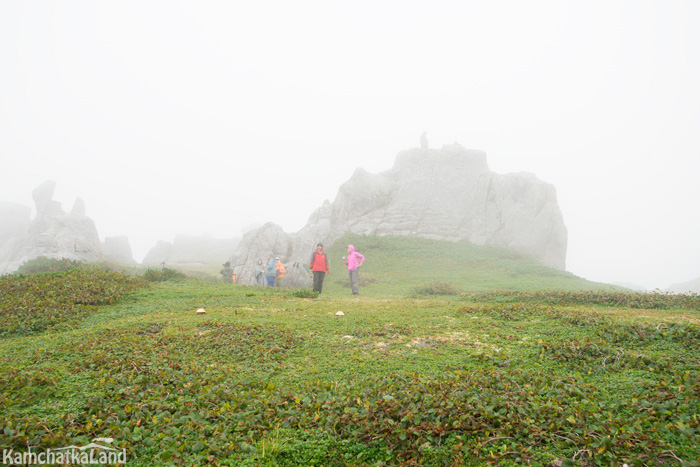
Therefore we advise you – prepare clothing for a trip to Kamchatka very well! Extra warm clothing, waterproof boots and raincoat will not be unnecessary. As our local guides say “we haven't seen any sweltered tourists”.
The origin of the Kuril lake
The maximum depth of the lake is 316 meters, its water is fresh. Its fault is a volcanic-tectonic depression which was formed by hollowing-out of the Earth’s crust about 8300-8400 years ago because of the powerful eruption.
The formed depression is a caldera located on the height of 104 meters above sea level, and it was filled with water from rain and melting snow. A few islands located on the lake are created by lava layers. This is cone-shaped islands, such as Chayachy, Low, Alaid’s Heart, Samang archipelago and thay have a height of 200-300 meters.
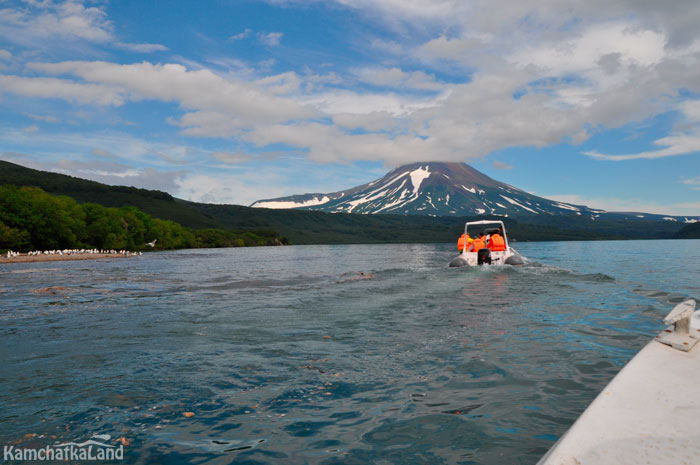
A few rivers and some streams flow into the lake, such as Etamynk, Vychenkiya, Kirushutk, Hakytsin, the Ozernaya river flows out to the west, to the sea of Okhotsk. A lot of fishes swim up the river to spawn and to give a life for fishes. This is the drainage lake. Kuthiny Baty are pumice outcrops associated with flash of acid volcanism in the early Holocene. The height of pumice formations in the area of the Kurile Lake reaches more than 100-110 meters.
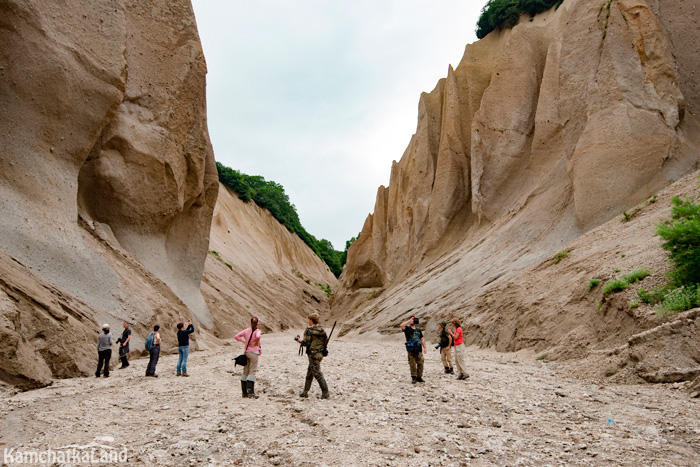
The Sanctuary’s neighbors and nature sightseeing
Lake Kuril is a very interesting place due to numerous reasons. There are interesting neighbors for tourists. For instance, the famous Ilianskaya sopka located on the northeast shore.
There are places for capes helping to achieve the natural harmony. The Tugumynk cape juts the south of the lake, and the Pulomynk cape juts the northwest of the lake. Beauty is worth of a talented artist’s brush. It is not necessary to say that the South-Kamchatka Sanctuary is always in demand among tourists.
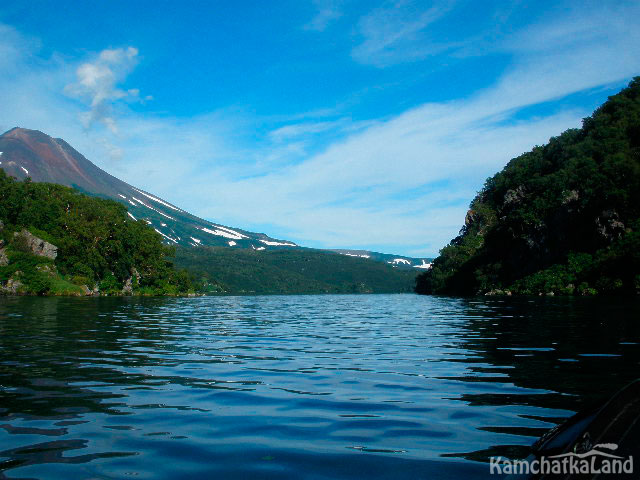
That’s not all! After arriving here you will hear the songs of the water sang by the rushing rivers and lakes:
- Vychenkiya
- Etamynk
- Kirushutk
- Hakytsin
The river with a wonderful name of Ozernaya, playfully flows into the Sea of Okhotsk situated at the west of the peninsula. There are a lot of springs filled with mineral water located at the shore of Teplaya (Warm) bay. Thus, you will have an extra reason to go on the south of Kamchatka.
Pauzhetka village is located on the border of the Sanctuary where a group of tourists, taking vehicle-trekking tour, stops for spending a night.
From there it is possible to take a trip along heavy-going and long road to the unique phenomena – White Waterfalls which are located on one of the slopes of Koshelevsky volcano.
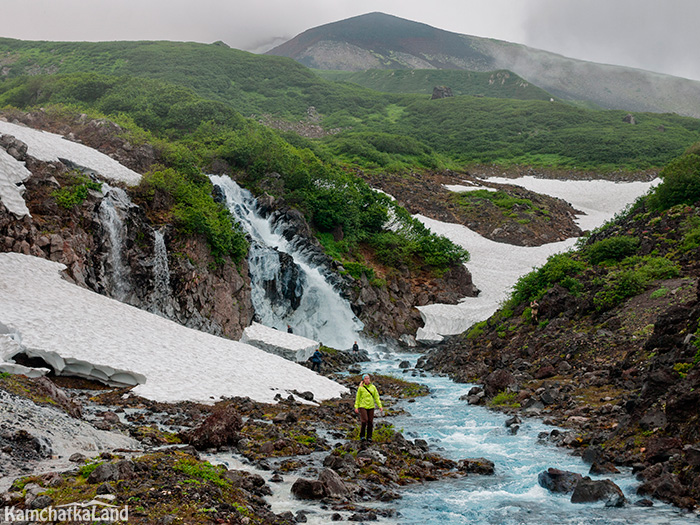
The water from melting of snow and glaciers on the slopes of the volcano flows through Earth’s crust and dilute minerals and then emitting it to the surface. At once the minerals settle down and paint numerous riverbeds of streams in ghostly white color. While approaching it is possible to note the milky (white) rivers from a distance. After reaching the river you can collect water and you notice that the water become transparent. Effect of whiteness is achieved thanks to the painted riverbed which is always renewed by nature.
Earlier we led a group of tourists to White waterfalls but difficult hiking road and steady rains at this place of the Sanctuary provoked different disagreements. So, we decided not to conduct a hiking trip there. We hope that the feeling of discoveries and search for new places takes the first place in our mind above a need for comfort and we will be able to see milky rivers again with you.
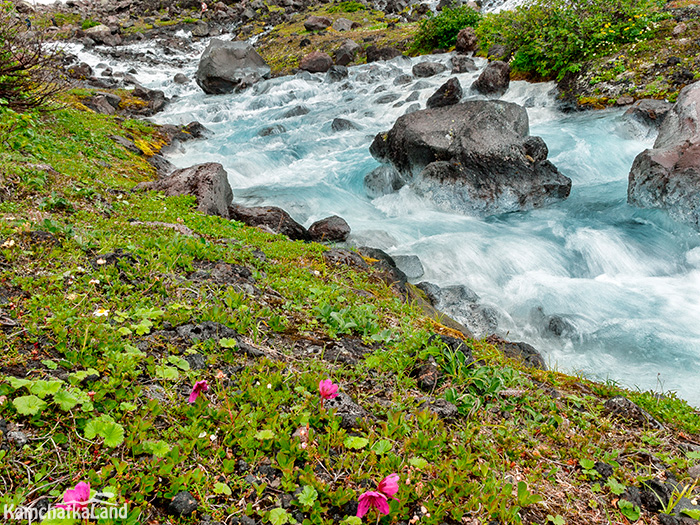
The next interesting site is one of our favorite places, Kamenny Gorodok (Stone Town). This unique place was created by wind.
It is called a town because it is similar to the stone remains of ancient settlement which was collapsed long ago. There you will be able to walk along the streets and visit some clefts. This is a place of ancient and mystery power which is felt everywhere.
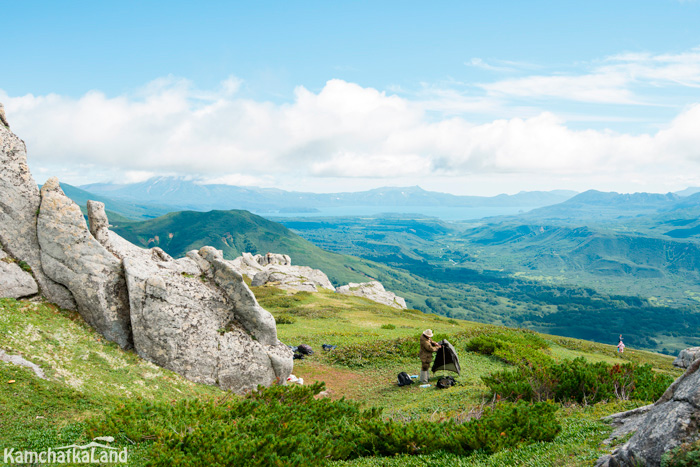
A road to Stone Town is also nor easy. It takes about 3-4 hours to reach it and you will have to ascend along the dry riverbed through shrubs and stony places, but when you reach the top of the hill with a height of 850 meter, you will understand that every efforts were not in vain. The stunning panorama opens before you: in the distance the Kurile Lake is shining from the sun, the Ozernaya river meanders like a snake, and the Pauzhetka village “smoke” from the right side.
You will want just to sit on the stone under warm sunshine and silently enjoy beauty of nature.
Flora and Fauna of the Kuril lake
Kuril Lake is the largest spawning of sockeye salmon, family of Pacific salmon around all Eurasia. There the population varies between 1.5-3.5 million specimens. Spawning is very long: it lasts from March to October, and causes some features of the lake ecosystem.
Spawning is important not only for the ecosphere of the local area, but for the entire peninsula, that is why TINRO Special Observation station takes a responsibility for accounting of spawning salmons and for future breeds. The station locates on the west shore where it fulfills its mission.

After alevins break their eggs they swim in the birthplace for some time and then swim to the Pacific Ocean to feed by themselves. After a few years they return back following their instincts.
The same salmon looks differently in the salty water of the Pacific Ocean and in the freshwater rivers and lake. In addition, during spawning the female stops searching food and change silver color to the bright red color and male salmon has changes in their body: it became larger and develops a kype at the distal tip of the lower jaw.
It is roughly estimated that number of fish species swimming up to the Kuril Lake is about 10 million per year, and in some years it reaches about 20 million. This is one of the largest migration of red salmon in Asia after the largest Kamchatka river on the peninsula.
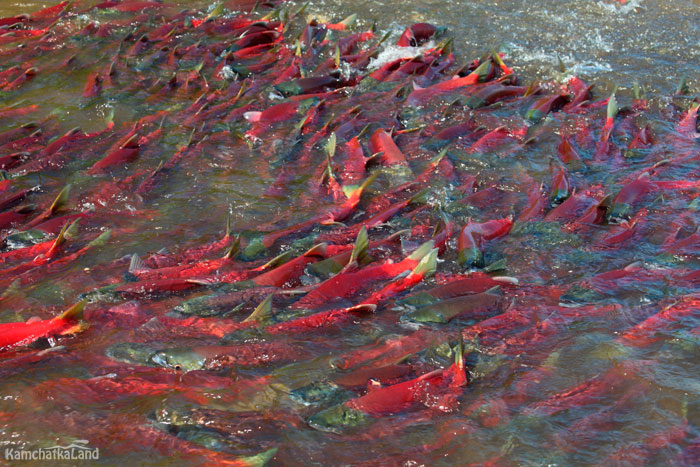
Nowadays, a lot of fish factories locate along the shore of the Sea of Okhotsk and along the banks of the Ozernaya river which is out of the area of South-Kamchatka Sanctuary. The technology for catching fish has a very high level so that all spawning fishes can be caught. In order not to stop nature balance the fish factories’ work is limited by ''spawning" days when it is prohibited to catch a fish and the last one reach its goal without any difficulties on the way. Over the past decades the population of red salmon recovered after a ruthless catch in the middle of 19th century thanks to a complex of environmental protection measures.
Salmon run along the riverbed of the Ozernaya river is not steady. On the way the salmon settle on the different depths. It takes about 4 day to reach the place of spawning from the ocean. The peak of mass migration lasts from the mid of July to the beginning of September. That’s the time we will plan to visit the area with an organized group of tourists.
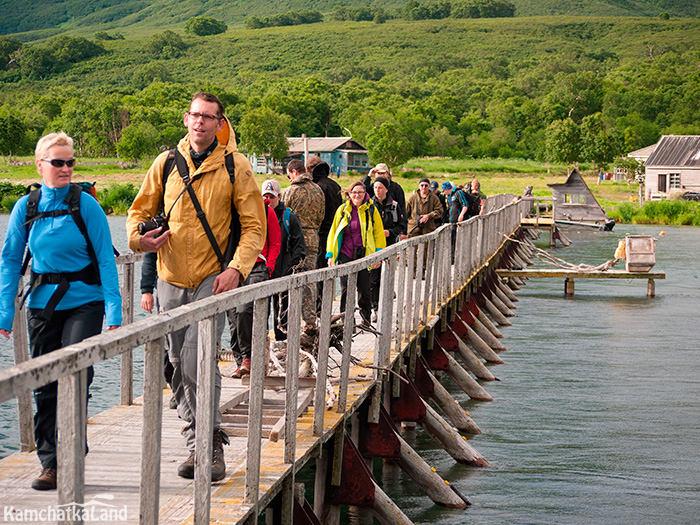
The red salmon is not the only habituating fish there. There are a lot of other fish species, such as: pink salmon, Chinook salmon, chum salmon, Arctic char there.
The Sanctuary attracts tourist not only by a spectacle of red water colored with fish, but also by bears which come there to feast fishes.
As a rule, about 200-250 Kamchatka brown bears come to the area of the lake in August, they are under the protection of the South-Kamchatka Sanctuary. Bears, river otters and foxes feast fatty salmons. Bears really like fishing on the Kuril Lake!
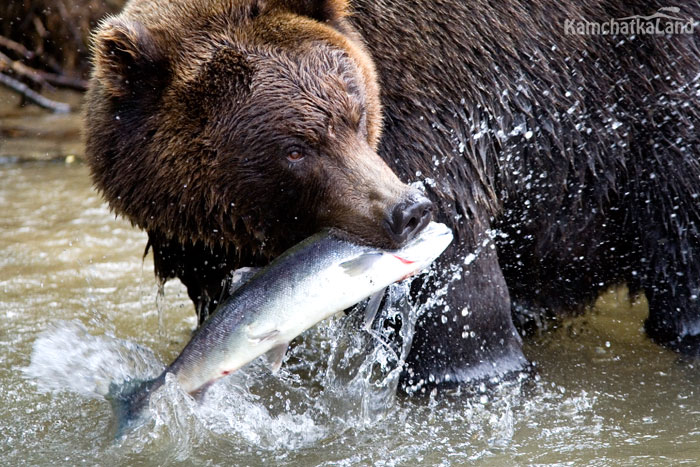
The abundance of bear forage and Sanctuary worker’s protection has an impact on bear’s behavior. They have more time to play with each other and for having rest. That is a fact which attracts wildlife photographers from around the world. In the Internet you have probably seen photos of dancing bears or sad bears siting on the background of Iliynsky volcano, cubs catching fish by using a branch and a lot of other one. Most of photos of bears taking part in different contests, was made on the area of Lake Kuril.
The largest colony of Pacific gull inhabits on islands of the Kuril Lake. There are more than 1500 species on freshwater. In winter, the species diversity on the lake increases. The large predators come there: about 400-700 Steller's sea eagles, 100-150 white-tailed eagles, around 50 golden eagles. Their greatest groups habituate on the spawning areas, such as: between the Hakytsyn and the Etamynki rivers, as well as on Ozernaya River.

Several hundred whooper swans and 1,5-2 thousand of wild ducks spend the winter in open waters. Sockeye salmon and its eggs is the food for all species of birds, including even the types of vegetarians, and small forest birds (nuthatch, small spotted woodpecker, etc.).
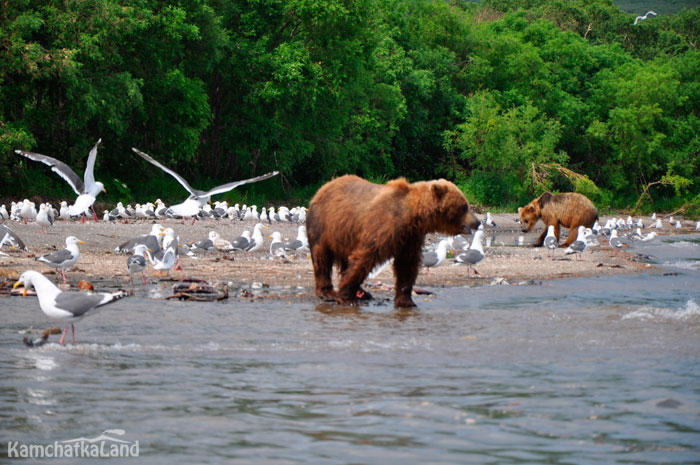
During autumn migrations the species of passerine visit the Kuril Lake. It is very simple to explain their choice: the Kuril Lake is the only suitable place for staying before leaving the Kamchatka peninsula through the Lopatka Cape. There are simply no places for stopping for passerines to the south.
The origin from the depth of the ages
Time stopped there. This is real fact, but there is a story that is filled with various interesting events. So, earlier the natives chose this place for settlement, and their largest fortified settlement located at Siyushk Cape.
There people lived, loved, worked, as well as called various natural objects, which are closely intertwined with the legends recorded by Stepan Krasheninnikov during hiking:
"Earlier at the place where the lake is located now, there was a majestic mountain and it was so high that it overshadowed the nearby mountains and eclipsed its sunlight. Of course, its neighbors were angry because of it. A quarrel started and as a result, the "high mountain" became fed up with the neighboring mountains and volcanoes, so "high mountain" could not bear that anymore and went straight into the Sea of Okhotsk. And later the lake appeared in its place, which to this day keeps its heart. The high Mountain, going into the sea, left a trail behind itself, the river Ozernaya followed it along that trail."

It’s a very interesting interpretation, is not it? Another interesting fact is that the locals (and the world) is called “Alaid’s heart” rocky island, it is located directly to the south of the lake, and, of course, it is similar to the shape of a heart. Stepan Krasheninnikov has managed to accurately describe the many places that have been preserved to present days.
Ilyinsky volcano is one of the stunning and most memorable sights of the Kurile Lake, which is located at the north-eastern of the lake. The volcano has a cone-shape top with a height of 1578 meters. The young lava flows of Ilyinsky volcano descend directly into the lake, so that it creates several bays.
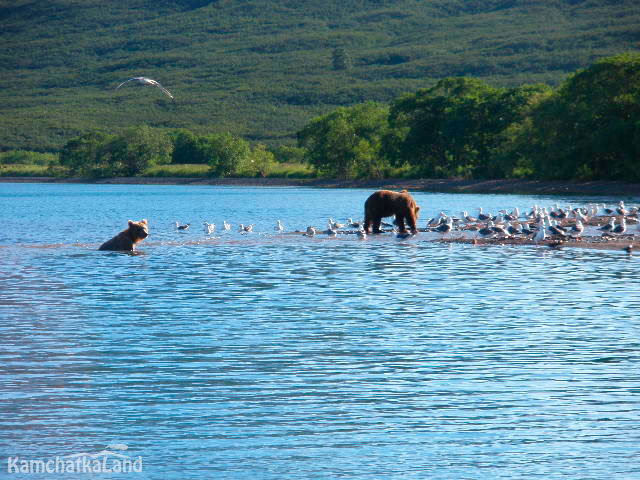
There are thermal springs located at the base of the volcano in the Teplaya Bay. It is called Kurilskye hot spring in the honor of the lake. The springs hide between lava boulders which are covered with cedar wood and stone birch. The spring water reaches 45°C.
The western shore of the lake is bordered by Wild Ridge mountain range (1080 m). In calm weather the volcanoes are reflected on the surface of the Kuril Lake. The wonderful landscape opens before you, so that you cannot stop enjoying nature beauty. Probably, a kingdom beyond the seas looks like that.
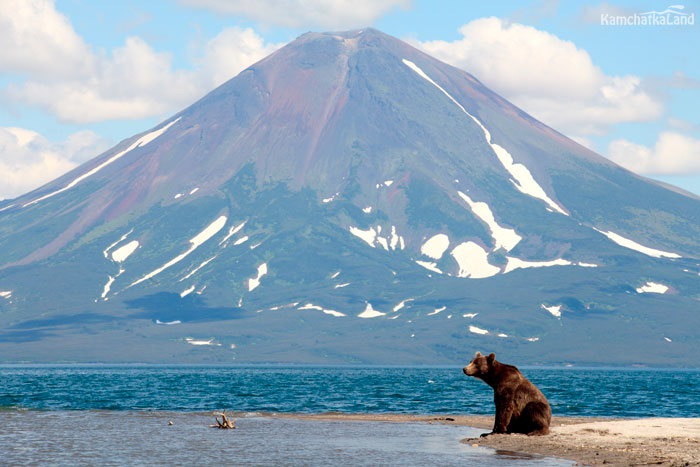
Popular tours with Kamchatkaland
Ready-made packages for your travel and vacation in Kamchatka

